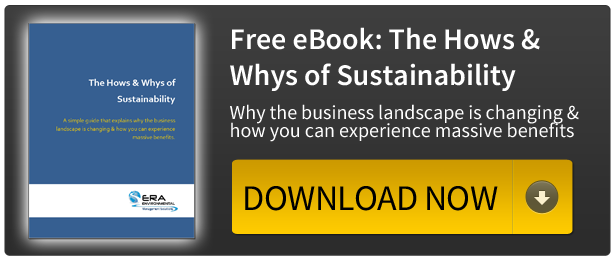This article is part of ERA’s three part series, Sustainability: Going Beyond Compliance. Part one develops a definition of sustainability and what it means for your business.

Sustainability is a buzzword that has been floating around for the past few years in the manufacturing industry, but what exactly does it mean? Despite the fact it gets thrown around and lauded by almost every big manufacturer, the definition of sustainability has remained hazy.
That’s because sustainability is a complex concept, and one that can apply to many different aspects of the manufacturing process.
The Capability for Continuous Growth
Essentially, sustainability is about being able to ensure your business can continue to thrive indefinitely. Some of the most successful businesses have already embraced this dedication to long-term success.
For example, Proctor and Gamble has committed to an ambitious environmental sustainability program with the end goals of:
- Powering all plants with 100% renewable energy
- Using 100% renewable or recycled materials for all products and packaging
- Having zero consumer and manufacturing waste
By aiming for 100% renewable energy and resources, P&G is taking action to make sure it will never be lacking in energy or the resources to manufacture its products. This isn’t just good for the environment; it’s great for P&G!
Placing a Focus on Balance
Sustainability also places a focus on making sure your business doesn’t use up more than it gives back and that you ensure the security of the resources you need to create your products.
To be completely sustainable, every resource that you use needs to be replaced eventually. Otherwise you are running on a deficit; one that will eventually catch up with you. The most basic illustration of this is found in the forestry industry, in which a new tree is planted for every tree that gets cut down.
Of course, most manufacturing processes are far more complex than this. Although we are constantly improving our technology and ability to recycle the resources we do have, there are still limitations to how renewable we can be.
For example, electric vehicle (EV) batteries are recyclable, but the process is not 100% effective and not always cost-effective. Although EVs are an incredibly sustainable option in the vehicle market, manufacturers are still working towards making them 100% sustainable.
But it is important to realise that because some processes are not 100% sustainable today, companies should still focus on making them as sustainable as possible. The "85% method" is one that should be applied across the board, meaning that with some short-term applied effort, it is possible to get to 85% of a solution. Getting to 100% may take years, but getting to 85% will still yield massive benefits for your organization.
In instances when we are not able to be 100% sustainable in a direct way, many manufacturers are finding ways to offset their resource deficit by creating new opportunities elsewhere. Carbon offset programs have grown over the last few years, as has the number of companies investing in research in green technologies.
This act of balancing what we take from the environment with what we give back is at the core of sustainable manufacturing. By not creating a resource deficit, we guarantee that there will always be resources at hand for us to use.
Sustainability Puts You in the Larger Context
Sustainability can be measured on many levels - a single workshop, a large facility, an entire company - but it always puts your environmental performance into the larger context.
It’s about making sure your business is contributing to the success of the entire planet. Many companies have faced serious public backlash after they've been perceived to actively be placing their own private gains ahead of the environment and the communities they depend upon.
If your company is aiming for sustainability, but still depends on unsustainable partners or suppliers, then your efforts will be in vain. Building a sustainable product also requires having a sustainable supply chain.
It shouldn’t be a surprise that many global manufacturers are now demanding their suppliers to get sustainable too, even asking for environmental sustainability reports.
Sustainability is a Business Reality
The theory of sustainability can seem daunting, especially when it comes to the concept of being “100%” or “completely” sustainable. In reality, few businesses are in a position to accomplish this type of sustainability yet.
But that’s OK! As we mentioned, the "85% method" should be your focus and provide a really strong starting point for your organization. This simple commitment to become more sustainable can create enormous benefits to your overall performance and the environment.
It will even help your bottom line. You can read more about how sustainability is good for business in part five of this series.
Most manufacturers want to get more sustainable by reducing their impact on the environment while making their processes more efficient. The reality of sustainability for most businesses is this: doing more while using less.
And that is something any business can accomplish.
... the rest of this series will tell you how.
Continue mastering sustainability by reading part two in ERA’s Going Beyond Compliance series: Nine Principles of Sustainability Planning.
Image credit: chrisjohnbeckett
This blog was co-authored by:


Tags:
Sustainability
February 21, 2013


Comments